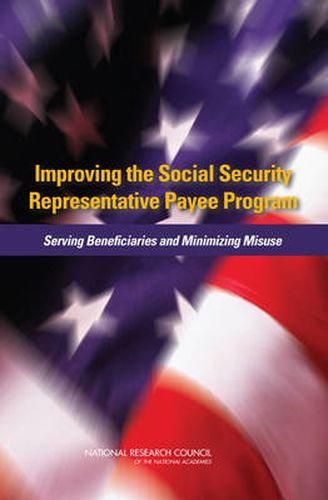Readings Newsletter
Become a Readings Member to make your shopping experience even easier.
Sign in or sign up for free!
You’re not far away from qualifying for FREE standard shipping within Australia
You’ve qualified for FREE standard shipping within Australia
The cart is loading…






More than 7 million recipients of Social Security benefits have a representative payee - a person or an organization - to receive or manage their benefits. These payees manage Old Age, Survivors and Disability Insurance funds for retirees, surviving spouses, children, and the disabled, and they manage Supplemental Security Income payments to disabled, blind, or elderly people with limited income and resources. More than half of the beneficiaries with a representative payee are minor children; the rest are adults, often elderly, whose mental or physical incapacity prevents them from acting on their own behalf, and people who have been deemed incapable under state guardianship laws. The funds are managed through the Representative Payee Program of the Social Security Administration (SSA). The funds total almost $4 billion a month, and there are more than 5.3 million representative payees. In 2004 Congress required the commissioner of the SSA to conduct a one-time survey to determine how payments to individual and organizational representative payees are being managed and used on behalf of the beneficiaries. To carry out this work, the SSA requested a study by the National Academies, which appointed the Committee on Social Security Representative Payees. This report is the result of that study. Improving the Social Security Representative Payee Program: Serving Beneficiaries and Minimizing Misuse: assesses the extent to which representative payees are not performing their duties in accordance with SSA standards for representative payee conduct; explains whether the representative payment policies are practical and appropriate; identifies the types of representative payees that have the highest risk of misuse of benefits; and, finds ways to reduce the risk of misuse of benefits and ways to better protect beneficiaries.
$9.00 standard shipping within Australia
FREE standard shipping within Australia for orders over $100.00
Express & International shipping calculated at checkout
More than 7 million recipients of Social Security benefits have a representative payee - a person or an organization - to receive or manage their benefits. These payees manage Old Age, Survivors and Disability Insurance funds for retirees, surviving spouses, children, and the disabled, and they manage Supplemental Security Income payments to disabled, blind, or elderly people with limited income and resources. More than half of the beneficiaries with a representative payee are minor children; the rest are adults, often elderly, whose mental or physical incapacity prevents them from acting on their own behalf, and people who have been deemed incapable under state guardianship laws. The funds are managed through the Representative Payee Program of the Social Security Administration (SSA). The funds total almost $4 billion a month, and there are more than 5.3 million representative payees. In 2004 Congress required the commissioner of the SSA to conduct a one-time survey to determine how payments to individual and organizational representative payees are being managed and used on behalf of the beneficiaries. To carry out this work, the SSA requested a study by the National Academies, which appointed the Committee on Social Security Representative Payees. This report is the result of that study. Improving the Social Security Representative Payee Program: Serving Beneficiaries and Minimizing Misuse: assesses the extent to which representative payees are not performing their duties in accordance with SSA standards for representative payee conduct; explains whether the representative payment policies are practical and appropriate; identifies the types of representative payees that have the highest risk of misuse of benefits; and, finds ways to reduce the risk of misuse of benefits and ways to better protect beneficiaries.